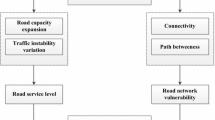Abstract
In order to analyze topological properties and vulnerable elements of urban road complex network, 98 lines and 128 nodes are selected by taking Shiyan city in China as an example. Firstly, the definitions of the urban road network’s running state vulnerability and structural vulnerability are proposed in this paper, and the assessment indexes are given respectively. From the perspective of the urban road network topology’s structural characteristics and the traffic demand characteristics, the internal relationship of the running state vulnerability and the structural vulnerability is introduced in order to show the necessity and reasonableness of the urban road network vulnerability assessment. Secondly, the concepts of the urban road network element’s structural-running state parameters are proposed to identify the source of network vulnerability. The Original Method is used to acquire the topology of the urban road network. Finally, with static vulnerability assessment principle, the structural vulnerability index is calculated on the premise that the cascading failure is not considered. With dynamic vulnerability assessment principle, the running state vulnerability index is calculated on the premise that the propagation effects of traffic congestion are considered. The results show that the vulnerability of road network is influenced by two factors: network topology structure and network running state.





Similar content being viewed by others
References
Von Ferber, C., Holovatch, T., Holovatch, Y., et al. (2009). Public transport networks: Empirical analysis and modeling. The European Physical Journal B., 68(2), 261–275.
Zhang, H., & Li, J. (2015). Modeling and dynamical topology properties of VANET based on complex networks theory. AIP Advances, 5(1), 017150.
Zhang, H., Li, J., & Lv, Y. (2014). Structure performance analysis of vehicular ad hoc networks based on complex network theory. Computer Modelling & New Technologies, 18(2), 46–51.
Zhang, H., & He, L. (2015). Modeling and topological properties of a V2I sub network in VANET based on a complex network. Cybernetics and Information Technologies, 15(4), 149–160.
Xiao, Y. (2013). An Integrative vulnerability evaluation model to urban road network based on complex network theory. Huazhong University of Science and Technology.
Zou, Z. Y., Lai, J. Y., & Gao, J. Z. (2013). Reducing the vulnerability of network by inserting modular topologies. Chaos: An Interdisciplinary Journal of Nonlinear Science, 23(1), 13121.
Zhi-Heng, D. H. L., & Yi, Z. (2010). Robustness analysis model of urban transit networks. Journal of South China University of Technology (Natural Science Edition)., 3, 13.
Xu, F., Zhu, J. F., & Yang, W. D. (2013). The complex network’ applications in transportation network: A survey. Complex System and Complexity Science., 01, 18–25.
Zhang, P., Cheng, B., Zhao, Z., et al. (2013). The robustness of interdependent transportation networks under targeted attack. EPL (Europhysics Letters)., 103(6), 68005.
Costa, L. D. F., Travencolo, B., Viana, M. P., et al. (2010). On the efficiency of transportation systems in large cities. EPL (Europhysics Letters), 91(1), 18003.
Shen, B., & Gao, Z. (2008). Dynamical properties of transportation on complex networks. Physica A: Statistical Mechanics and its Applications, 387(5), 1352–1360.
Wu, J. D., Zhu, S. Y., Wang, H., et al. (2012). BP neural network-based space distance cognition of drivers at dusk. Journal of Wuhan University of Technology (Transportation Science and Engineering)., 04, 740–743.
Zhang, H., & Li, J. (2014). Dynamical topology analysis of VANET based on complex networks theory. Cybernetics and Information Technologies, 14, 172–186.
Zhang, H., & Li, J. (2015). Topological characteristics and control approach for VANET. Journal of Transportation Systems Engineering and Information Technology, 15(2), 81–87.
Zhang, H., & Lv, Y. (2017). Information flow characteristics analysis of vehicular ad-hoc network. Chinese Journal of Engineering Mathematics, 34(05), 449–457.
Acknowledgements
The research is sponsored by China Automotive Test Cycle (CATC) project and by Transportation Department of Inner Mongolia Autonomous Region (NJ-2017-8). We are grateful to the anonymous reviewers for their insightful comments and recommendations.
Author information
Authors and Affiliations
Corresponding author
Additional information
Publisher's Note
Springer Nature remains neutral with regard to jurisdictional claims in published maps and institutional affiliations.
Rights and permissions
About this article
Cite this article
Zhang, H., Yao, Y. An Integrative Vulnerability Evaluation Model to Urban Road Complex Network. Wireless Pers Commun 107, 193–204 (2019). https://doi.org/10.1007/s11277-019-06248-7
Published:
Issue Date:
DOI: https://doi.org/10.1007/s11277-019-06248-7




